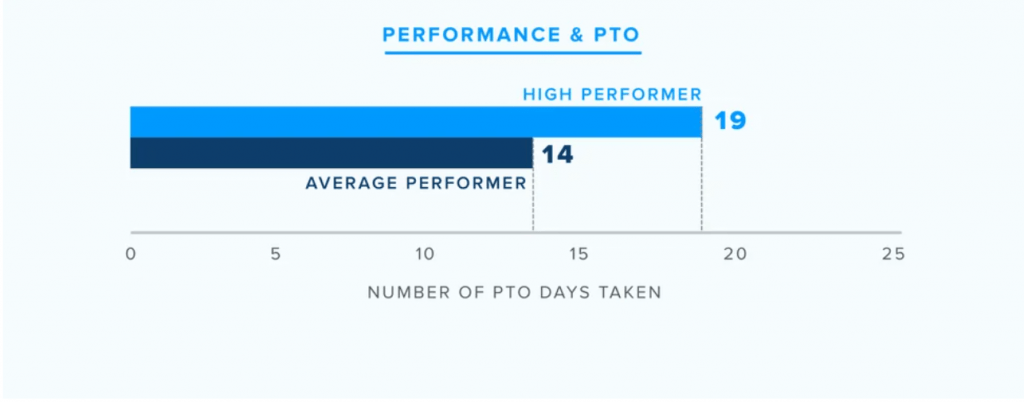As organizations increasingly strive to enhance employee experience, the concept of unlimited paid time off (PTO) is rewriting the rules of traditional vacation policies.

PTO is a highly valued benefit among workers, even surpassing employer-paid health insurance and retirement programs in terms of priority. This sheds light on the growing demand for flexibility when taking time off.
However, unforeseen obstacles lie beneath the surface of this celebrated approach to work-life harmony. Boundaries are blurred, long-standing employees raise their eyebrows, and the very policy praised for balance may inadvertently produce the opposite effect.
This article provides a clear and comprehensive explanation of unlimited PTO, including the differences in PTO usage and preferences across different groups, critically evaluates the advantages and disadvantages of the policy, and recommended practices for its implementation.
Pressed for time? Here’s a quick summary…
-
Unlimited PTO is a policy in which employees are not assigned a specific amount of vacation time within a given period. Instead, they have the freedom to take paid time off from work at their discretion without any set limits imposed by the company.
-
Income disparities and generational differences affect PTO usage. Older individuals with higher incomes are more likely to take extended time off for leisure, travel, and family time than lower-income individuals or younger employees.
-
Unlimited PTO can reduce employee absences, improve performance, lower accumulated expenses, and serve as an effective tool for recruitment and retention.
-
Vague boundaries, the possibility of creating a work-centric environment, and resistance from longer-tenured staff are factors that can lead to employee resentment of unlimited PTO.
-
To effectively implement a PTO strategy, organizations should align their policy with company values, set mandatory minimums, and encourage management to lead by example.
What Is Unlimited Paid Time Off?
Unlimited paid time off (PTO) is an employee benefit that allows workers to take as much time off from work as needed, without a predefined limit, while still receiving pay. This approach differs from traditional PTO, which has employer-set limits. Unlimited PTO focuses on results, offering flexibility with minimal administrative oversight. The system typically forgoes time tracking, emphasizing job performance and work expectations instead.

Unlimited PTO includes various types of leave:
- Vacation time is a scheduled period when employees take time off work for rest, relaxation, or recreation, typically lasting between a few days and two weeks. This is usually requested and pre-planned to avoid work disruption.
- Sick time is an absence from work due to an illness, injury, or caring for an ill or injured family member, often unplanned and taken to recover or seek medical treatment.
- Personal days are non-illness or non-vacation days off work, used at the employee’s discretion for personal matters like appointments, moving, mental health breaks, or family emergencies.
- Bereavement leave is taken to mourn the death of a family member, with the duration and eligibility determined by the employer’s policies.

- Paid holidays are company-provided paid days off to celebrate public holidays or spend time with family, with some companies giving the option to work for extra pay.
- Floating holidays are paid days off that employees choose for themselves, either for unrecognized public holidays or personal events like birthdays or anniversaries.
- Parental leave is paid time off upon the arrival of a new child encompassing maternity, paternity, and adoption leave, varying in duration and eligibility between companies.
- Jury duty is an obligation of US citizens to participate in the judicial system, with many employers providing paid time off for employees summoned to serve on a jury. The duration depends on the selection process and trial requirements.
- Paid volunteer time off (VTO) allows employees to take paid time off to volunteer for community programs and non-profit organizations, promoting corporate social responsibility and encouraging employee involvement in their local area.
Pros & Cons Of Unlimited PTO
Exploring the benefits and considerations of unlimited PTO can help inform an organization’s approach to optimizing vacation time.
Pros
Fewer Absences
Unlimited PTO doesn’t turn the office into a ghost town. Instead, the policy’s flexibility eliminates the pressure to use vacation days before they expire, reducing unnecessary time off. Employees with unlimited PTO take similar or fewer vacation days than those with traditional PTO arrangements.
Heightened Performance & Innovation
Taking more time off work prevents burnout and correlates with better performance. Research shows that higher-performing employees take an average of five more vacation days per year than underperforming employees.

Companies observe an increase in energy and creativity when employees return from vacation. For example, spend management company Emburse reports that employees often return from PTO with new ideas for product designs and features.
Lower Accumulated Expenses
In states where unused vacation days are required to be paid out to employees, unlimited PTO reduces such financial obligations.
Improved Recruitment & Retention
Many modern candidates seek autonomy and flexibility, making unlimited PTO a powerful perk for talent acquisition and employee retention.
Cons
Limited Boundaries
Despite its name, unlimited PTO is not truly unlimited. Organizations may decline paid time off for valid reasons, such as extended leaves (e.g., one year of PTO for caregiving responsibilities) or critical work obligations like deadlines, presentations, or performance issues. Without the objectivity of earned vacation hours, this can breed employee resentment if their time off requests are denied.
Work Pressure

Unlimited PTO can inadvertently create a work-centric environment, negatively impacting work-life balance. Without clear limits, employees might feel pressured to prioritize work over taking time off due to factors like a motivated boss, perceived competition with colleagues, or a sense of guilt for burdening co-workers with additional responsibilities (43%).
Resistance From Current Employees
Long-standing employees who have accumulated vacation hours over the years may have planned to use them as a severance bonus. If the change to a new system coincides with flat earnings or downsizing, employees might question the organization’s motivations.
Least Preferred Flexible Work Arrangement
While it remains a desirable benefit, Wellable’s pulse check reveals that unlimited PTO is employees’ least favored option of all flexible work arrangements, with only 10% selecting it as their top choice. Remote work emerges as the most preferred arrangement (39%), followed by a shortened work week (28%) and flexible hours (23%). When it comes to workplace flexibility, employees value being able to work from where they want above all else.
Income, Generation, & Gender Differences In PTO Use & Preferences
A striking 89% of employees agree that PTO is vital to their job satisfaction, indicating that generous vacation packages are indispensable. However, age, generation, and income groups vary in PTO usage and preferences.
Differences By Income Levels

Employees who primarily take time off work for medical emergencies, family obligations, or personal reasons earn about $22,000 less than those who take time off for leisure. This may be due to lower-income individuals shouldering caregiving responsibilities without the means to take a break, while higher-income employees have the financial resources to seek support for such situations.
Differences By Generation
Older workers express a greater need for extended time off than younger employees. Baby boomers, for example, often enjoy greater financial stability than younger generations and seek longer breaks to travel and spend time with family.
Differences By Gender
Sixty percent of women indicate that they never check their email while on PTO, compared to only 40% of men. The same percentages (60% and 40%) claim PTO is necessary for their workplace happiness.
Best Practices For Managing Unlimited PTO Successfully
Unlimited PTO has gained traction in the workplace, with one-fifth of employers embracing this policy. However, organizations must address employee concerns and tackle potential challenges to optimize its advantages. By implementing best practices, organizations ensure a positive and effective policy that benefits employees and employers alike.

Align Policy With Company Values
Organizations that have successfully implemented unlimited PTO display a genuine commitment to employee well-being and fulfillment. By framing unlimited PTO as a policy that supports organizational values like work-life balance, job satisfaction, and employee happiness, employers foster a workforce that is engaged and dedicated to the company’s mission and success.
Redefine Success
Employees may believe their value within a company is based on the number of hours they work, hindering them from taking necessary time off and leading to burnout. Instead of focusing on time, use quality of work as a measure of success. This mindset enhances productivity and promotes work-life harmony.
Set Mandatory Minimums

Over half of employees worry they may fall behind at work if they take time off, while smaller percentages mention concerns about hindering their chances for career progression (19%) or even jeopardizing their job security (16%). These worries may stem from fear of being perceived as less hardworking or taking advantage of the time-off policy, adding unnecessary stress and undermining PTO’s purpose as a benefit.
Implementing a mandatory minimum requirement for taking time off can combat these concerns. Goldman Sachs, for example, requires all employees to take at least three weeks of vacation every year. Smaller companies, such as photo-book company Chatbooks, are following suit. Mandatory minimums create a positive and supportive work environment where employees feel encouraged to prioritize their well-being.
Plan Ahead
Planning vacation time in advance facilitates a smooth transition for the rest of the team and ensures that employees are complying with mandatory minimum vacation policies. By proactively scheduling time off on calendars, the HR team can monitor PTO utilization rates and reach out to managers if employees aren’t taking sufficient vacation time. This approach is not about surveillance but rather creating an environment where employees feel comfortable and supported to take time off and recharge.

Lead By Example
Leadership plays a critical role in shaping the company culture around unlimited PTO. When organizational leaders actively take PTO, it sets a powerful precedent for employees to follow suit. Reduce the stigma around taking time off by showing it’s not only allowed but encouraged, whether for a dream vacation or a mental health day. This can be achieved by creating a company-wide group chat where employees share vacation photos and self-care strategies for PTO. Expressing genuine interest in employees’ vacation plans and discussing the benefits of resting and recharging further reinforces its importance.
Examples Of Unlimited PTO Policies

From innovative start-ups to corporate giants, companies of all sizes are recognizing the value of giving employees the flexibility to manage their time on their terms. Here are 10 organizations that have an unlimited PTO policy:
- Netflix: Netflix champions a decade-long commitment to unlimited PTO. In the words of CEO Reed Hastings, “Today, in the information age, what matters is what you achieve, not how many hours you clock. So, why should I care if [an] employee works 50 weeks a year or 48 weeks a year?”
- Sony: Sony’s unlimited PTO policy reflects its commitment to work-life balance, recognizing that relaxation fuels productivity.
- GameChanger: GameChanger knows that life happens outside the office: “Take time off work and travel the world. Enjoy unlimited vacation time.”
- Bending Spoons: Bending Spoons goes beyond unlimited PTO, offering a $1,000 stipend for breaks of five days or longer. It’s a tangible encouragement for employees to recharge.
- Wellable: Wellable’s commitment to employee well-being shines through its unlimited PTO policy, understanding that balance is essential for mental health.
- Asana: Asana’s unlimited PTO policy is framed by flexibility and trust. The only “limit” is common sense. Get the work done and don’t stress about time off.
- Moov Financial: Moov believes in taking time off when needed because there’s life outside of work.
- Hubspot: In addition to a company-wide week off in July, Hubspot encourages autonomy through their unlimited PTO policy.
- Kronos: Kronos switched to unlimited PTO in 2016. CEO Aron Ain cites increased leave without abusing the policy, showcasing a positive shift in trust and work-life balance.
- Teachable: Teachable offers an unlimited PTO policy and flexible hours outside the traditional 9-5.
Is Unlimited PTO Right For Your Organization?
Despite its potential limitations, unlimited PTO is a beneficial approach for organizations that prioritize results and quality of work over mere presence. By embracing unlimited PTO, organizations foster a culture of trust and autonomy, empowering employees to take responsibility for their time and well-being. It encourages workers to recharge, maintain a healthy work-life balance, and consequently enhances their overall performance and job satisfaction. Regardless of the industry, most organizations can benefit from a shift towards this inclusive and forward-thinking approach, enabling teams to thrive and deliver exceptional results while nurturing a sustainable and fulfilling work environment.
This article was last updated on February 13, 2024












